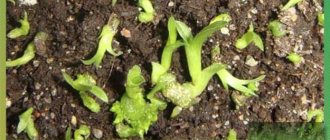Planting cacti with seeds is a popular way to obtain viable, well-formed plants adapted to indoor conditions. In order to successfully implement this idea, it is not at all necessary to be an experienced cactus grower. Alternatively, cactus seeds are available at any large seed store.
For your first experience, you can purchase a bag of mix and simply enjoy the process from the moment of sowing to the first shoots. And how interesting it is to recognize in small, not yet formed cacti that they belong to one species or another...
You can plant seeds all year round. But in spring and summer, when the climate is more favorable, it will be much easier to get seedlings.
Mammillaria
A very popular and widespread type of cactus, which is often found in home collections. There are several varieties of it - small and medium in size, with a cylindrical and spherical trunk, with different spines, with and without pubescence. Plants are unpretentious in care. It is very important for them to find a well-lit place, water regularly but moderately and prevent pests.
With proper care, the cactus blooms in the warm season. Small flowers (no more than 2 mm) from white to bright pink appear on the trunks. Some species (Mamillaria saboae, Mamillaria de-herdtiana, etc.) have larger flowers.
Container and substrate for growing cactus
The size of the container depends on the variety and shape of the prickly friend. A short cactus with a highly branched root system should be planted in a low and wide pot , a plant with long roots - in a narrow and deep container.
Plastic or clay pots of square or rectangular shape are considered practical. These dimensions allow you to grow several crops at the same time.
It is recommended to place high-quality drainage at the bottom of the container: river pebbles or coarse sand with pebbles. Laying out is carried out in 2 layers: the first - on the bottom of the container, the second - in the upper part of the soil.
Queen of the Night (Selenicereus grandiflorus)
This truly unique cactus, which has almost smooth shoots, did not get its beautiful name by chance. The exquisite and sophisticated beauty of cactus blossoms and the pleasant strong aroma of flowers force gardeners to choose this particular plant for their collection. And, despite the fact that the huge flowers (more than 30 cm in diameter) bloom only for one night, and placing this cactus with shoots that reach several meters in length is quite problematic, Selenicereus deserves the effort spent so that it can be admire the spectacular blooms.
Euphorbia (Euphorbia)
A well-known plant among cacti lovers, it got its name because of the viscous viscous liquid released when the stems and leaves are broken. Do not try to taste this liquid - it is poisonous. In ancient times, arrowheads were moistened with milkweed juice. The stems of milkweed are triangular in shape, covered with thorns, and quite tall. It is not difficult to keep this cactus at home, but it is important to ensure that the plant is inaccessible to children.
Shlumbergera, or Decembrist
This cactus was first discovered in the forests of Brazil, where it was called Schlumbergera or zygocactus. However, in our country he is better known as the Decembrist. This species is popular and widespread due to the beautiful flowers that bloom in December.
The cactus has a rather unusual spreading shape. It can grow up to 1.5 meters wide. Unlike most members of the Cactus family, this plant does not have thorns and loves frequent and abundant watering, and does not tolerate direct sunlight.
Reproduction
This method is most often used in breeding work, because cacti also reproduce well vegetatively. But sometimes propagation of cacti by seeds is also used in indoor floriculture, for example, when it is not possible to purchase a grown plant of a certain variety. You need to prepare everything you need to grow these thorny plants and be patient. The fact is that plants grown from seeds can bloom for the first time no earlier than five years after sowing.
cactus seeds
These exotic plants are becoming increasingly popular in our country. However, even many experienced gardeners do not always know what cactus seeds look like, since these plants are often propagated vegetatively. Today you can purchase a wide variety of seeds of these plants in specialized stores. Anyone interested in how to grow a cactus from seeds should know that the process is long, but extremely interesting. Beginners in indoor floriculture usually choose seeds of columnar, fast-growing cacti that bloom after a few years, for example, rebutias or a mix of seeds of different varieties.
It is necessary to know well the types of home cacti and what the seed should look like so as not to avoid disappointment in the future. Often, flower growers who use seeds for propagation for the first time fail to achieve the desired result. In the photo below and further in the article, you can see what cactus seeds look like.
You can collect seeds from plants in your collection. For cross-pollination, you need to have two cacti that were grown from seeds or cuttings of different plants. The flowers from which you plan to take pollen must be fully open so that the pollen can be easily separated and can be collected on a brush. Pollen from one flowering plant is transferred to the flower of another. After some time, a berry appears in place of the flower.
To propagate a cactus by seeds, you must use a fully ripened berry. You should break it very carefully and remove the seeds. They can be stored for two years in a paper bag, signed with the name of the variety and the date of collection of the seeds.
Land selection
To sow cacti, it is necessary to prepare a substrate consisting of:
washed river sand (1 part);- leafy rotted earth (1 part);
- crushed charcoal (1/2 part).
And drainage from fine expanded clay or perlite. You can prepare the soil and drainage yourself or purchase ready-made soil from a specialty store. The main requirement for the soil mixture is lightness and breathability.
Cactus seeds do not have a mechanism to resist infections, so before planting, the soil must be disinfected by keeping the mixture in the oven for 15-20 minutes, and the drainage must first be doused with boiling water. You can add broken eggshells to the drainage.
How to germinate cactus seeds?
If you want to grow this amazing plant from seeds, make sure that the variety or species you choose is not subject to genetic mutations and retains all varietal characteristics. Before sowing cacti with seeds, you should learn about the basic rules.
The seeds of these plants germinate slowly. The seedlings also develop slowly. Despite the fact that seeds require heat and moisture for germination, it should be borne in mind that seedlings of these plants are very susceptible to various fungal diseases. It is for this reason that when sowing it is necessary to maintain a certain temperature and humidity, trying to prevent the development of fungal diseases.
The seeds should be soaked for a day. For this, a weak solution of potassium permanganate is most often used. It is not recommended to use growth stimulants for this purpose - their effect on cacti has not yet been fully studied.
Seed packets should be opened over a sheet of paper. Cactus seeds are so small that they look more like dust. Therefore, such precaution will help preserve the seed material. Soaking will not only awaken the seeds, but also remove any remaining pulp. This significantly reduces the risk of mold formation in the soil and provides a healthy environment for growing cacti from seeds.
In order for the seeds to germinate, it is necessary to maintain the air temperature during the day within the range of +26 to +30 ° C, and at night reduce it by ten degrees.
Cactus seed sowing technology
Before planting, the seed material must be prepared. To do this, they are soaked in a weak solution of potassium permanganate for 10 hours, then taken out and dried. After this, you can begin the process.
Sowing
Stages of sowing cactus seeds:
- Place drainage in the prepared mini-greenhouse, pour 5 cm thick soil on top and water thoroughly with boiled warm water. Overflow should not be allowed, otherwise you will have to wait until the soil dries out;
- Level the wet soil and make small holes for seeds, 2 cm apart;
- Place a seed in each hole, without falling asleep on top;
- Close the container with a lid and place it on the windowsill.
Already in the first week you can detect the first shoots of planted plants.
You can open the container only after thorns appear on the seedlings. They really need oxygen.
Soil and dishes
Cactus seeds can be sown in wide, low containers, for example, made of styrofoam, which are first washed with very hot water, but not with boiling water. A clay convex shard is placed on the drainage hole in the bottom of the container. A drainage layer of expanded clay or small pebbles is poured onto the bottom, which is first spilled with boiling water.
The container for germinating seeds is filled 2/3 full with loose soil mixture for cacti. It should contain a large amount of perlite or coarse sand. Many experienced gardeners believe that the soil should be baked in an oven or microwave. In other words, disinfected to provide maximum protection against fungal diseases.
On top of the soil mixture is covered with a layer of crushed basalt, broken brick or sand (coarse-grained) about a centimeter. The material is first sifted, bringing the grain size to 2 mm. After this, they are washed to remove small particles, dried and scattered over the surface of the soil. This layer will not become a breeding ground for pathogens of various diseases.
Preparing the pot
What is the best way to plant? It is better to plant seeds in a shallow plastic container - up to 8 cm in height. Containers should have plenty of drainage holes at the bottom. Matte white containers that do not absorb much sunlight are best suited. The pot must be equipped with a tray to drain excess liquid. A mandatory element is a transparent lid. This can be glass or a transparent plastic cap (cup, lid) that covers the planted seeds.
Important! Before sowing, the container must be sterilized by subjecting it to prolonged boiling and treating with a solution of potassium permanganate.
Sowing
Sowing cacti with seeds is carried out evenly over the entire surface of the previously prepared container. To do this, you need to fold a piece of paper in half, pour the seeds into the resulting groove, then, lightly tapping the paper slightly inclined towards the soil, pour the seeds evenly onto the soil surface.
Due to the fact that cacti grow slowly and develop more actively in the community, the seeds are sown quite densely. After sowing, they are lightly pressed into the soil using any object with a smooth surface, for example a matchbox. Since seeds need light to germinate, they are not sprinkled with soil on top. The soil is not watered, but sprayed with a spray bottle.
The container is covered with glass and placed in a place with artificial heating. It is necessary that the earth warms up to +30 °C during the day and to +20 °C at night. Seedlings in a container are placed on a central heating radiator (in winter) or on a heating pad.
Sowing cacti from seeds: step-by-step instructions
To grow cacti from seeds, you need to create greenhouse conditions. This is not very difficult to do. All you need is a shallow and small plastic container with a lid. A simple and inexpensive option is a food container. Also prepare drainage, specialized soil for cacti and a spray bottle with warm water. Now start planting:
- Soak the seeds for 30-40 minutes in a weak solution of potassium permanganate. Treatment will help destroy fungal infections and awaken the seeds.
- If there are no drainage holes at the bottom of the container, make some. Excess water from the soil will pass through them into the pan.
- Place a layer of drainage 1-2 cm high at the bottom of the mini-greenhouse.
- Fill the top with a layer of soil 3-4 cm thick. Make sure that the soil level does not reach the edge of the container by about 2 cm.
- Flush the soil well with boiled warm water. But don't overwater the soil. If this happens, wait until the ground dries out a little.
- Make shallow grooves in damp soil. Maintain a distance between rows of 2 cm.
- Plant the seeds in the holes at intervals of at least 2 cm. Do not sprinkle soil on top under any circumstances. Seeds germinate only on the surface of the soil.
- Spray the plantings with warm water from a spray bottle. Close the container with a transparent lid. Place it in a well-lit place. The air temperature inside the greenhouse should be +25°C.
Soak the seeds and prepare a mini-greenhouse
Fill a layer of soil on top, moisten it, make grooves and plant seeds
Spray the plantings with warm water from a spray bottle
Caring for cactus seedlings
The first shoots of cacti will appear within the first week after sowing. But they will be uneven. There is no need to be upset, such spasmodic germination is the norm for cacti. Crops take a long time to germinate – within a month.
Ventilation . The mini-greenhouse cannot be opened until the first shoots are visible through the transparent lid. Then you need to start regularly ventilating the greenhouse. Moreover, each time the intervals should increase. You can completely remove the lid from the greenhouse when spines appear on small cacti and begin to noticeably increase in size.
Hydration . It is important to maintain optimal soil moisture. The soil should not dry out. Waterlogged soil will cause seedlings to rot. How do you know when the soil needs to be moistened? Test the soil by touch. If it is almost dry, then you can start watering. You cannot water seedlings from a watering can or bottle. The flow of water may be too traumatic for small seedlings. Gently moisten the crops with water from a spray bottle or water each plant using a pipette.
Lighting . Young seedlings require a lot of light. The mini-greenhouse should be placed on a windowsill, well illuminated by a natural or artificial light source. But it is necessary to protect the greenhouse from direct sunlight. Additional illumination should last no less than 8 and no more than 12 hours a day.
Transplant . After 3 months, the grown seedlings must be planted in separate containers. While they are still small, a plastic cup or small pot is quite suitable for them. Don't forget to make drainage holes in them to remove excess moisture.
Picking
When the seedlings in the container begin to create a clump (dense cushion), they should be planted in fresh soil. At the same time, the soil mixture in the planting tray must be dry - in this case, it easily disintegrates and it will not be difficult to remove the seedlings without damage. Young cacti grown from seeds, which by this time have reached up to a centimeter in diameter, are planted in larger containers, several at a time.
After transplantation, seedlings are kept in a shaded, warm place. A few days after transplantation, carefully water the cacti. How often should this be done during this period? Experienced gardeners believe that the soil must be moistened as it dries.
After about a week, when the seedlings adapt to fresh soil, they are transferred to a slightly shaded but bright place. Plants begin to grow and develop a little faster.
Replanting a cactus
About 1.5 years ago I grew a pitahaya cactus from seeds. The advantage of this variety is that it can be grown as a hanging crop. This means that over time the shoots will begin to droop and hang out of the pot like bindweed. An “ampeloid” cactus will look very unusual and impressive.
How to choose a pot for planting?
Before planting, carefully select the pot. The reference point will be the root system of the seedling. Remove the plant from the old pot and inspect the roots. In some specimens they grow wider, but do not descend much to the lower part of the pot. For such plants, choose wide and shallow flowerpots. There are varieties in which the roots grow in length. As is correct, such cacti have a tap root, not a fibrous root. A deep, but not wide pot is good for them.
The general rule for any type of cactus is that the container should not be much larger in size than the root system when expanded. At the same time, do not forget that some part of the volume will be filled by drainage. In our case, the pitahaya cactus is planted. It grows quickly and occupies the entire area of the flowerpot, so you can take a large pot to transplant such a seedling. Does the material from which the container is made matter? No, this is not a fundamental criterion. It is much more important to choose the right soil.
What should the soil be like?
The main requirements for it are good water and breathability. The soil should be loose, well ventilated and, no matter how strange it may sound, poor. Only in poor soil can cactus roots develop harmoniously. The easiest option is to buy a ready-made soil mixture for cacti and succulents.
If necessary, the soil can be prepared at home. You need to take 1 part universal peat soil and 1 part sand. Then add soil loosening agents - vermiculite, perlite, fine expanded clay or gravel, zeolite or diatomite. All ingredients are thoroughly mixed. The result is poor soil - an ideal environment for cactus growth.
Crop care
It is important not only to know how to grow a cactus, how to prepare and sow the seeds. It is necessary to understand what kind of care seedlings require. First of all, you should properly organize the watering of cacti. How often and how to carry out this procedure so as not to harm young plants? Sometimes in special publications you can find recommendations from flower growers about immersing containers with seedlings in water to moisten the soil. But this old method was used before the advent of fine sprays. Now they are used to water the soil once a day.











